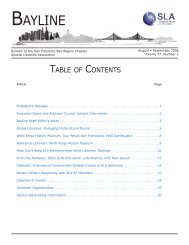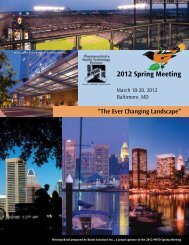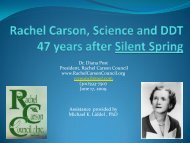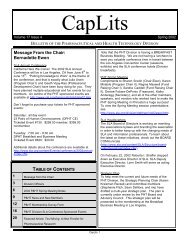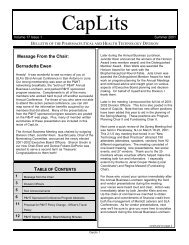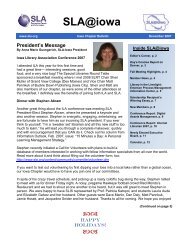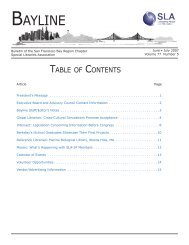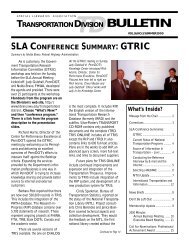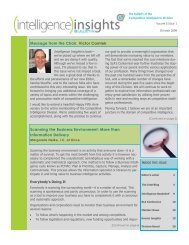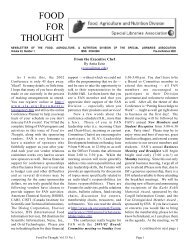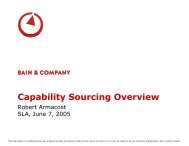Education Libraries - Special Libraries Association
Education Libraries - Special Libraries Association
Education Libraries - Special Libraries Association
You also want an ePaper? Increase the reach of your titles
YUMPU automatically turns print PDFs into web optimized ePapers that Google loves.
of library-created digital learning materials and tutorials.<br />
The remaining chapters of the work include one<br />
concerning diversity and the need for cross cultural<br />
instruction, making instructional sessions culturally<br />
relevant to all students, taking into account the most<br />
appropriate instructional strategy for optimizing student<br />
learning.<br />
“The Future of Information Literacy” is a great title for<br />
the final chapter of this slim volume, but does not live up<br />
to its promise, merely summarizing current efforts rather<br />
than taking on the difficult task of formulating opinions<br />
as to the opportunities for academic libraries in the<br />
future. This book may be helpful to librarians who are<br />
not fully aware of how to teach, but I’m not sure that it<br />
reaches its promise. That said, it’s an important work for<br />
librarians responsible for information literacy instruction<br />
who do not have training as educators. They will benefit<br />
by rounding out their interest in providing information<br />
literacy instruction by reading this book and taking to<br />
heart all that must surround good content to assure that<br />
learners absorb what is taught and are able to apply it in<br />
other situations in the future.<br />
Barbie E. Keiser is a information resources<br />
management consultant located in the metro-<br />
Washington, DC, area. Email: barbieelene@att.net<br />
Teen Girls and<br />
Technology: What’s the<br />
Problem? What’s the<br />
Solution?—Reviewed by<br />
Michelle Price<br />
Farmer, Lesley. (2008).<br />
Teen Girls and<br />
Technology: What’s the<br />
Problem? What’s the<br />
Solution? New York:<br />
Teachers College Press.<br />
ISBN: 978-0-8077-4875-<br />
6 (paperback), 978-0-<br />
8077-4876-3<br />
(Hardcover). $21.95 (pa.),<br />
$52. (cloth).<br />
Lesley Farmer, a very prolific writer, made a great<br />
decision when she decided to write Teen Girls and<br />
Technology. A quick look at Worldcat, Amazon, Books<br />
in Print, and Google Books and you can see that there is<br />
hardly anything monographic written about the subject.<br />
There are books that address teens and technology, but<br />
they usually only have a chapter or two devoted to<br />
females. Farmer’s book goes beyond the one chapter<br />
model to fully address the complex issues surrounding<br />
teen girls use of technology. The first section of the book<br />
is devoted to the teen tech girl’s reality where Farmer<br />
discusses the current situation for female teenagers and<br />
technology in terms of societal, family, social,<br />
economic, government and academic issues.<br />
Refreshingly, Farmer does not limit the scope of her<br />
book just to the United States, but takes a more global<br />
approach. In the introduction she gives a glaring<br />
example of the American teen girl who is unaware of the<br />
proliferation of her techie teen girl counterpart in Japan.<br />
After framing the situation in a global view, Farmer then<br />
spends parts II and III of the book focusing on success in<br />
the United States. She accomplishes this by laying out<br />
the stakeholders and elements for success in part II and<br />
then giving lesson or project ideas for schools,<br />
communities and families in part III.<br />
Given the title, this book is framed from the point of<br />
view that there is a problem with teen girls and<br />
technology. For a counterview, Dan Kindlon’s Alpha<br />
Girls, examines the new American girl that is thriving. It<br />
is based on his survey and interview data of teens across<br />
America and is compiled into long narrative chapters.<br />
For a well rounded collection, I would also recommend<br />
an earlier book by Farmer, Digital Inclusions, Teens and<br />
your Library. In Teen Girls and Technology, Farmer<br />
only devoted four pages to girl’s access to technology,<br />
but she devotes over 40 pages to access issues for teens<br />
in Digital Inclusions.<br />
Considering the psychological slant of Teen Girls and<br />
Technology, the potential audience is large. Specifically,<br />
public librarians could use this book for personal<br />
professional development or as part of a public library<br />
collection, the book would be handy for active parents or<br />
caregivers and community members involved with<br />
recreation or technology decision making. In general,<br />
this book is recommended for any library that has<br />
collections in psychology, sociology, management<br />
information systems, public administration, social work,<br />
communication, computer and information science, and<br />
education.<br />
Michelle Price is the Science and Outreach Librarian for<br />
St. John Fisher College in Rochester, New York. She<br />
previously reviewed books for <strong>Education</strong> <strong>Libraries</strong> as<br />
Michelle Dubaj, and up until this summer was Reference<br />
& Instruction Librarian at Reed Library, SUNY<br />
Fredonia, Fredonia, New York. Email: mprice@sjfc.edu<br />
<strong>Education</strong> <strong>Libraries</strong>, Volume 31, No. 2, Winter 2008 48



